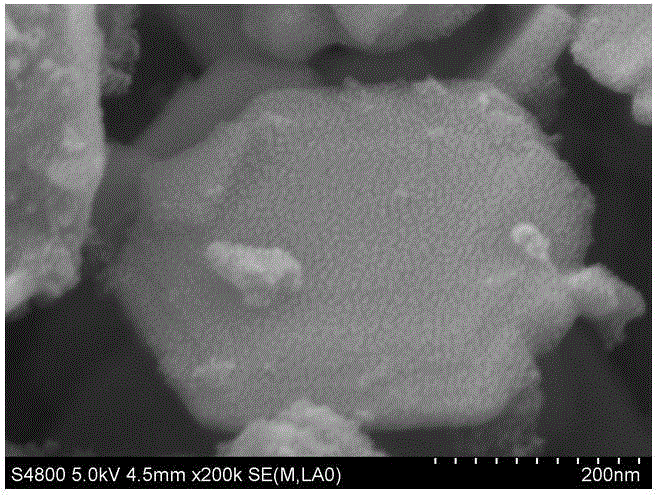Method for preparing nano molybdenum carbide (Mo2C) flake powder with regular-hexagon structure
A nanometer molybdenum carbide, regular hexagonal structure technology, applied in the direction of tungsten/molybdenum carbide, nanotechnology for material and surface science, carbide, etc., can solve practical application inconvenience, irregular shape particle size distribution range, the reaction product is heated internally and externally, etc., to achieve the effect of convenient operation, less impurity content, and reduced energy consumption
- Summary
- Abstract
- Description
- Claims
- Application Information
AI Technical Summary
Problems solved by technology
Method used
Image
Examples
Embodiment 1
[0025] Prepare the nano-molybdenum carbide flake powder with regular hexagonal structure as follows, specifically comprising the following steps:
[0026] 1) Dissolve 28.61g of ammonium dimolybdate and 21.39g of glucose in 250ml of distilled water, and stir until completely dissolved to obtain a precursor solution;
[0027] 2) Put the precursor solution obtained in step 1) in a blast drying oven, and dry it at 60°C for 5 hours to obtain a powdery precursor mixture;
[0028] 3) Put the powdery precursor mixture obtained in step 2) in a quartz tube furnace, and calcinate at 300°C for 1 hour under the protection of argon to obtain a "molybdenum oxide" in which the elements are uniformly mixed at the molecular weight level — carbon” mixture;
[0029] 4) Take the "molybdenum oxide-carbon" mixture obtained in step 3) to fill 1 / 2 of the volume of the ceramic crucible, and cover and fill the upper layer of the crucible with NaCl and KCl mixed powder with a molar ratio of 1:1; then pl...
Embodiment 2
[0032] Prepare the nano-molybdenum carbide flake powder with regular hexagonal structure as follows, specifically comprising the following steps:
[0033] 1) Dissolve 30.39g of ammonium dimolybdate and 19.61g of sucrose in 250ml of distilled water, and stir until completely dissolved to obtain a precursor solution;
[0034] 2) Put the precursor solution obtained in step 1) in a blast drying oven, and dry it at 80°C for 4 hours to obtain a powdery precursor mixture;
[0035]3) Put the powdery precursor mixture obtained in step 2) in a quartz tube furnace, and calcinate at 300°C for 1 hour under the protection of argon to obtain a "molybdenum oxide" in which the elements are uniformly mixed at the molecular weight level — carbon” mixture;
[0036] 4) Take the "molybdenum oxide-carbon" mixture obtained in step 3) to fill 1 / 3 of the volume of the ceramic crucible, and use NaCl and BaCl with a molar ratio of 1:1 2 The mixed powder covers and fills the upper layer of the crucible;...
Embodiment 3
[0039] Prepare the nano-molybdenum carbide flake powder with regular hexagonal structure as follows, specifically comprising the following steps:
[0040] 1) Dissolve 27.94g of ammonium heptamolybdate and 22.06g of glucose in 250ml of distilled water, and stir until completely dissolved to obtain a precursor solution;
[0041] 2) Place the precursor solution obtained in step 1) in a blast drying oven, and dry it at 100°C for 3 hours to obtain a powdery precursor mixture;
[0042] 3) Put the powdery precursor mixture obtained in step 2) in a quartz tube furnace, and calcined at 400°C for 0.5h under the protection of argon to obtain a "oxidized Molybdenum - carbon" mixture;
[0043] 4) Take the "molybdenum oxide-carbon" mixture obtained in step 3) and fill 1 / 2 of the volume of the ceramic crucible, and cover and fill the upper layer of the crucible with KCl powder; then place the crucible in a quartz tube furnace, in a hydrogen atmosphere at At 800°C for 3 hours for reduction ...
PUM
| Property | Measurement | Unit |
|---|---|---|
| thickness | aaaaa | aaaaa |
Abstract
Description
Claims
Application Information
 Login to View More
Login to View More - R&D
- Intellectual Property
- Life Sciences
- Materials
- Tech Scout
- Unparalleled Data Quality
- Higher Quality Content
- 60% Fewer Hallucinations
Browse by: Latest US Patents, China's latest patents, Technical Efficacy Thesaurus, Application Domain, Technology Topic, Popular Technical Reports.
© 2025 PatSnap. All rights reserved.Legal|Privacy policy|Modern Slavery Act Transparency Statement|Sitemap|About US| Contact US: help@patsnap.com

